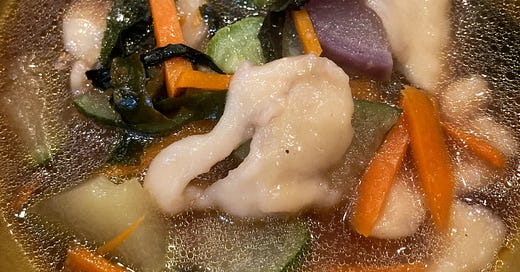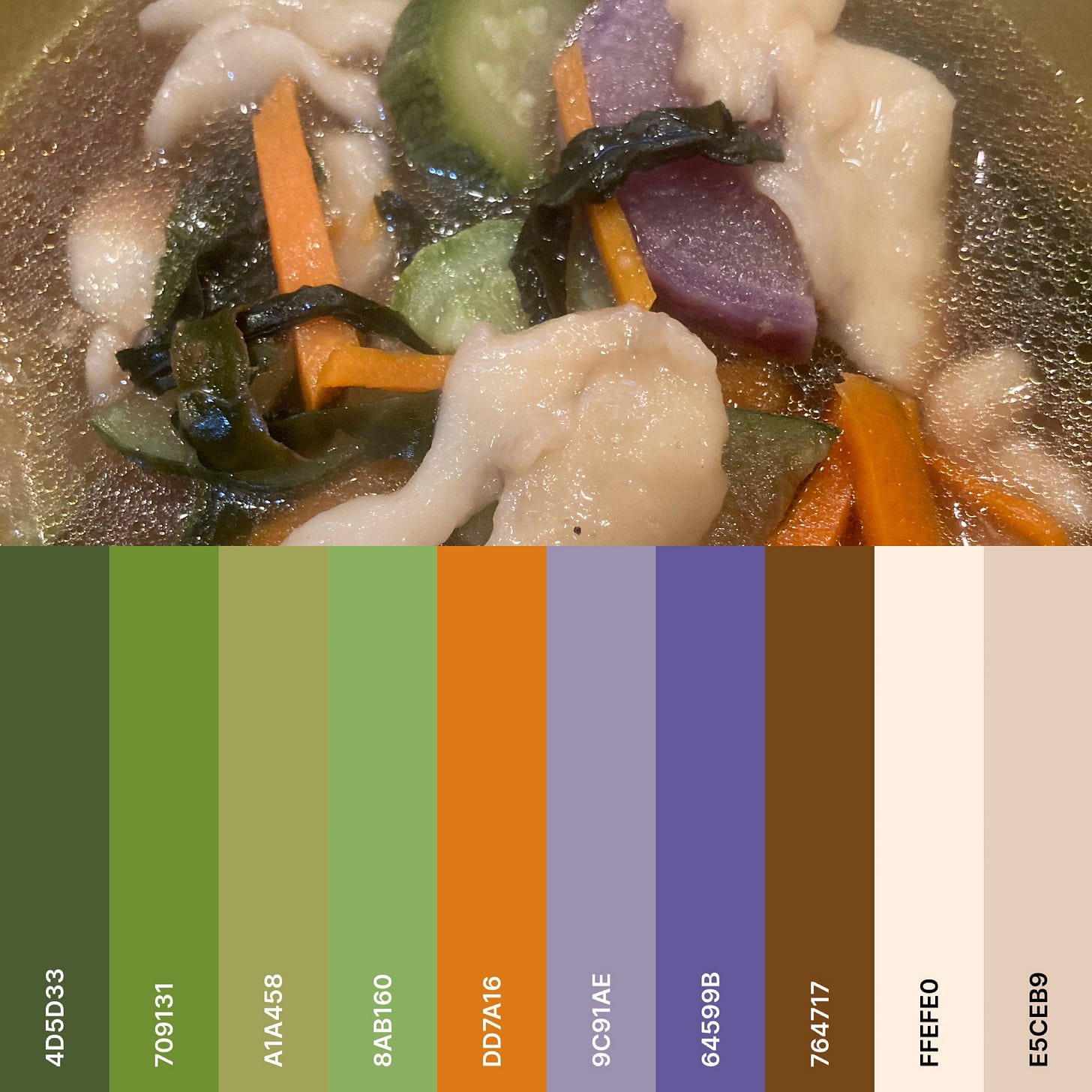Survival food
When does something from your survivor past become a vital part of your present?
I’d never had sujebi before, mainly because my mother never made it for us, and my father never requested it. Growing up Korean in 1970s America with so few other Koreans, let alone Korean restaurants, made it so that if my mom did not cook something, it did not exist in Korean cookery. I only knew of sujebi once Korean supermarkets became a thing; I asked my mother about the package of randomly shaped dough bits. She dimly recalled, “Oh, I guess we could make that—” while simultaneously walking away from me and the package.
So, I never asked again.
In my family, no meant no. It was a motto: “No means no.” Negotiation was not a possibility; negotiation was something I learned later on in my first job as a technical recruiter. The idea that a response or offer could be fungible blew my mind. To this day, I’ll negotiate a glass of milk if allowed. I love negotiation so much that I relished the process of buying my car ten years ago. Oh, but that’s another story.
When my daughter and I visited New York a few weeks ago and saw monkfish and mussel sujebi on the brunch menu at Her Name is Han in Koreatown, I put in my order. Korean restaurants are sometimes an exploratory and introductory avenue to Korean cookery for me as it might be to someone having Korean food for the first time. Because sujebi is such a humble food, it’s not often offered on restaurant menus, either.
So given the opportunity, I put in my order. I was going to eat something that somehow was anathema in my childhood household.
It was very good. It turns out sujebi is a sort of spaetzle.
Or is spaetzle a sort of sujebi? Spaetzle is known to have originated in the 18th century, whereas sujebi appeared in Goryeo period cooking in 935AD. I’m kind of sick of referring to a Korean thing as something else that the Western world is more familiar with. Like gimbap: gimbap isn’t a kind of sushi, and sushi isn’t a kind of gimbap. Hwedupbap isn’t a kind of spicy chirashi, though it is often called such on Korean menus.
Back to sujebi. My daughter fished it out of my soup and ate most of it.
“Would you like to make some once we get home?”
She unequivocally said yes.
So I made sujebi this week, kneading dough, letting it rest, and then later calling my daughter to help tear, roll, and toss it into boiling stock filled with vegetables (2024 is a bonkers year: my zucchini is still producing in November) from the garden and farmers market. We filled the soup with these pieces, and only stopped when it felt like there could be no room for more. When fully cooked, the sujebi looked like pieces of calamari.
She ate all of it. And returned to the stockpot to make more sujebi. She took some to school for lunch the next day, too.
It is strange how we turn away from some things and turn towards others. It is strange how one generation abhors a food because of its circumstances, and another generation embraces it. In Asian American Studies there is macro-level research on how the second generation turns away from the mother culture, only for the third generation to pivot back to their roots. But comfort food is implicitly more personal and immediate.
The word sujebi comes from “su,” which means hand and “jebi,” which means to fold. It is simple and cheap to make, with ingredients comprising simply of flour, water, and a pinch of salt. While making it, I could easily see how it could sustain an entire family on flour rations from the U.S. military. While making it, too, I could see how without a flavorful broth, sujebi could feel like punishment.
It instantly became a comfort food in our household. Now, it is part of a mother-daughter journey to New York City to experience Autumn, however intermittent. It is part of a Sunday morning memory. When my daughter eats it, she will experience the happiness that comes from exploration and discovery mingled with familiarity. It is part of a new pattern of history, where to my mother it was a survival food she despised, one that reminded her of poverty and scraping by. For her, sujebi was part of an emotional memory that she never wanted to revisit.
But what of other survival foods? My father hates sweet potatoes. My mother loves sweet potatoes because she said they saved her life when she was struck with severe dysentery in post-war Korea. They were the only things she could eat, except for the one banana that her eldest brother found on the black market and bought for a small fortune to save her life.
The US military dropped loads of spam into Korea. Other Korean citizens smuggled hot dogs and canned beans out of US military bases. Folks combined these ingredients with Korean ones (kimchi, dooboo, and gochujang) to make what became budaejjigae, which translates to “army base stew.” It has become a truly popular dish.
But again—my mother never served us budaejjigae. I’d never even heard of such a thing until well into my adulthood. But by then, people were raving about budaejjigae, which is made in a big pot and destined to be the centerpiece of a casual social gathering. And (if you don’t mind the high sodium), it is delicious. Cue Joey-Tribiani-eating-Rachel’s-trifle voice: Spam? GOOD. Hot dogs? GOOD. Canned beans? GOOD. Kimchi? GOOD. Dooboo? GOOD. Gochujang? GOOD. What’s not to like?
When does such a survival food become a comfort food? And under what circumstances does a survival food remain a reviled memory?
Does it have to be delicious?
When it comes to survival food in America, Thanksgiving turkey comes to mind. The ultimate survival food, the thing the pilgrims were given to eat by Indigenous People (who the Pilgrims and their descendants then murdered). Turkey is a tasteless bird that can, with skill, be brought to edibility; so many recipes on how to make it juicy prevail on the internet. Brining in salt, brining in buttermilk, dry-brining, frying, spatchcocking—the variations and attempts abound. In my opinion, turkey is truly only delicious as stock. But every year, turkey is the centerpiece food of Thanksgiving. And it has become a sign of comfort to many.
But let’s be honest. If you were a flight attendant and offered “Chicken? Beef? Turkey?” how many people would actually pick turkey?
My mother attempted turkey once.
I can count on one hand the times she cooked non-Korean food from scratch, but we requested turkey one year. As with all non-Korean food, she asked around for advice on how to make a turkey beforehand. Out of all the pieces of advice people gave her, one stuck in her head: slather it in mayonnaise.
(Let me tell you someday about the time she made spaghetti sauce; someone told her to put celery in it. I’m just gonna say that that spaghetti sauce was so…CRUNCHY. And not in the granola way).
We never used our oven. I didn’t even know the thing worked. But that year, my mom slathered a turkey in mayonnaise and stuck it in there. We nervously checked in on the bird, wondering when it was cooked. Luckily, my mom had the presence of mind to get one of those turkeys with the little red pop-up timer that pops out when it’s done.
Yo, my mom did not put salt, pepper, or anything on that bird. Just mayonnaise. We chewed on it in silence, cognizant that we’d asked something of our mom and she’d obliged us.
She was the first to speak, thank goodness.
“This is awful. Everyone, stop eating.” And then she got out some Korean leftovers from the refrigerator.
We never asked for turkey again. We returned to chicken soup.
So when I think of Thanksgiving turkey, I think of that first turkey as offering from Indigenous People whose generosity would not be returned. And I think of my mom’s turkey and how much she loved us and tried to indulge us in something she did not understand. And I think turkey is negotiable. And I think of Thanksgiving food as negotiable, too. And to this day, I always offer something at Thanksgiving that is NOT traditional (this year it was japchae).
But there are non-fungible foods when it comes to traditions, too. Like matzo at Passover.
You can’t have Passover without matzo, and you definitely cannot observe Passover with leavened bread. But no one thinks matzo is delicious, even if there are some more than adequate matzo-based dishes like matzo-brei and the forever-amazing-so-we-eat-them-even-when-it-is-not-Passover matzo ball soup. It is the matzo balls (originally called knoedel or kneidel) that have become comfort food, the thing we yearn for when we are feeling ill or wanting a food to enwrap us in generations of goodwill.
Kneidels weren’t invented until sometime in the 19th century; someone decided to turn leftover matzo into “matzo meal” and into dumplings. It took many centuries to turn a survival food into comfort. (I’m trying to wrack my mind for another matzo-based comfort food, but I can’t think of any. And I don’t know many people who reach for a piece of matzo when they’re feeling blue like they would reach for matzo ball soup). Out of all the variations on matzo, it is matzo ball soup that married comfort with survival, and out of all the variations, it is matzo ball soup that is delicious.
So maybe survival food has to be delicious in order for it to evolve into comfort.
Or maybe it has to be accompanied by a sumptuous broth, like sujebi. Whatever the accompaniment, there is a transformation that takes place, an emotional trajectory that accompanies an entire generation for a food to become a source of comfort.
We are heading into the stretch of weather and holidays filled with rich and tradition-oriented foods. We are heading into sleet and snow and rain, and sometimes treacherous ceremony. But in all of that, may there be one source of comfort. Maybe it’s a dumpling.





Wow did I laugh at the mayo turkey story. And it makes me wonder what spaetzle’s story is. This is lovely.
I just finished reading this, my first article written by you. Your backstory is fascinating, and it occurs to me that if you would be willing to share some of your recipes (I live in Kansas, and there are, quite literally NO Korean restaurants within driving distance), I’m willing to bet that people would love that. I know I would. I adore soups and stews, so reading about your beloved subeji (my apologies if misspelled), made my mouth water! You are a very talented and engaging writer, and I’m glad to have stumbled upon you!🌹